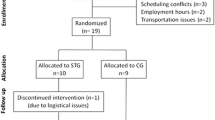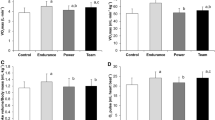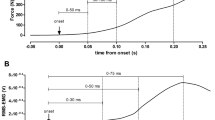Abstract
The aim of the present study was to examine muscle mechanical characteristics before and after a marathon race. Eight elite runners underwent a pre-test 1 week before the marathon and post-tests 30 min, two and five-day-post-marathon. Actual marathon race performance was 2:34:40 ± 0:04:13. Energy expenditure at marathon pace (EEMpace) was elevated 4% post-marathon (pre: 4,465 ± 91 vs. post 4,638 ± 91 J kg bodyweight−1 km−1, P < 0.05), but was lowered by 6 and 9.5% two- and five-day-post-marathon compared to EEMpace pre-marathon. Countermovement jump (CMJ) power decreased 13% post-marathon (pre: 21.5 ± 0.9 vs. post: 18.9 ± 1.2 W kg−1; P < 0.05) and remained depressed two- (18%) and five-day (12%) post-marathon. CMJ force was unaltered across all four tests occasions. Knee extensor and plantar flexor maximal voluntary contraction (MVC) decreased from 176.6 ± 9.5 to 136.7 ± 16.8 Nm and 144.9 ± 8.7 to 119.2 ± 15.1 Nm post-marathon corresponding to 22 and 17%, respectively (P < 0.05). No significant changes were detected in evoked contractile parameters, except a 25% increase in force at 5 Hz, and low frequency fatigue was not observed. In conclusion, leg muscle power decreased acutely post-marathon race and recovered very slowly. The post-marathon increase in EEMpace might be attributed to a reduction in stretch shortening cycle efficiency. Finally, since MVC was reduced after the marathon race without any marked changes in evoked muscle contractile properties, the strength fatigue experienced by the subjects in this study seems to be related to central rather than peripheral mechanisms.





Similar content being viewed by others
References
Allen DG, Lännergren J, Westerblad H (1995) Muscle cell function during prolonged activity: cellular mechanisms of fatigue. J Exp Physiol 80:497–527
Avela J, Komi PV (1998) Reduced stretch reflex sensitivity and muscle stiffness after long-lasting stretch-shortening cycle exercise in humans. Eur J Appl Physiol 78:403–410
Avela J, Kyrolainen H, Komi PV, Rama D (1999) Reduced reflex sensitivity persists several days after long lasting stretch-shortening cycle exercise. J Appl Physiol 86:1292–1300
Avela J, Kyrolainen H, Komi PV (2001) Neuromuscular changes after long-lasting mechanically and electrically elicited fatigue. Eur J Appl Physiol 85(3–4):317–325
Baldwin KM, Reitman JS, Terjung RL, Winder WW, Holloszy JO (1973) Substrate depletion in different types of muscle and in liver during prolonged running. Am J Physiol 225:1045–1050
Bergstrøm J, Hermansen L, Hultman E, Saltin B (1967) Diet, muscle glycogen and physical performance. Acta Physiol Scand 71:140–150
Billat VL, Lepretre PM, Heugas AM, Laurence MH, Salim D, Koralsztein JP (2003) Training and bioenergetic characteristics in elite male and female Kenyan runners. Med Sci Sports Exerc 35(2):297–304
Byrne C, Twist C, Eston R (2004) Neuromuscular function after exercise-induced muscle damage: theoretical and applied implications. Sports Med 34(1):49–69
Callow M, Morton A, Guppy M (1986) Marathon fatigue: the role of plasma fatty acids, muscle glycogen and blood glucose. Eur J Appl Physiol Occup Physiol 55(6):654–661
Caserotti P, Aagaard P, Simonsen EB, Puggard L (2001) Contraction-specifik differences in maximal muscle power during stretch-shortening cycle movements in elderly males and females. Eur J Appl Physiol 84(3):206–212
Cavagna GA, Saibene FP, Margaria R (1964) Mechanical work in running. J Appl Physiol 18:1–9
Chin ER, Balnave CD, Allen DG (1997) Role of intracellular calcium and metabolites in low-frequency fatigue of mouse skeletal muscle. Am J Physiol C272:550–559
Chleboun GS, Howell JN, Conatser RR, Giesey JJ (1998) Relationship between muscle swelling and stiffness after eccentric exercise. Med Sci Sports Exerc 30(4):529–535
Coggan AR, Williams BD (1995) Metabolic adaptations to endurance training: substrate metabolism during exercise. Exerc Metab cpt 6, Human Kinetics, Champaign, IL
Craib MW, Mitchell VA, Fields KB, Cooper T, Hopewell R, Morgen DW (1996) The association between flexibility and running economy in sub-elite male distance runners. Med Sci Sports Exerc 28(6):737–743
Davies CTM, Thompson MW (1986) Physiological responses to prolonged exercise in ultramarathon athletes. J Appl Physiol 61(2):611–617
Ebbeling CB, Clarkson PM (1989) Exercise-induced muscle damage and adaptation. Sports Med 7:207–234
Enoka RM, Stuart DG (1992) Neurobiology of muscle fatigue. J Appl Physiol 72(5):1631–1648
Farrell M, Richards JG (1986) Analysis of the reliability and validity of the kinetic communicator exercise device. Med Sci Sports Exerc 18:44–49
Franch J, Madsen K, Djurhuus MS, Pedersen PK (1998) Improved running economy following intensified training correlates with reduced ventilatory demands. Med Sci Sports Exerc 30(8):1250–1256
Gandevia SC (2001) Spinal and supraspinal factors in human muscle fatigue. Physiol Rev 81(4):1725–1789
Geronilla KB, Miller GR, Mowrey KF, Wu JZ, Kashon ML, Brumbaugh K, Reynolds J, Hubbs A, Gutlip RG (2003) Dynamic force responses of skeletal muscle during stretch-shortening cycles. Eur J Appl Physiol 90:144–153
Gleim GW, Stachenfield NS, Nicholas JA (1990) The influence of flexibility on the economy of walking and jogging. J Orthop Res 8(6):814–823
Gollnick PD, Saltin B (1988) Fuel for muscular exercise: role of fat. In: Horton ES, Terjung RL (eds) Exercise, Nutrition and Energy metabolism, Chap 5. MacMillan, New York, pp 72–88
Guezennec CY, Vallier JM, Bigard AX, Durey A (1996) Increase in energy cost of running at the end of a triathlon. Eur J Appl Physiol Occup Physiol 73(5):440–445
Hamada T, Sale DG, MacDougall JD (2000) Post activation potentiation in endurance-trained male athletes. Med Sci Sports Exerc 32(3):403–411
Harrison AJ, Gaffney SD (2004) Effects of muscle damage on stretch-shortening cycle function and muscle stiffness control. J Strength Cond Res 18(4):771–776
Holsgaard Larsen A, Caserotti P, Puggaard L, Aagaard P (2006) Reproducibility and relationship of single-joint strength vs multi-joint strength and power in aging individuals. Scand J Med Sci Sports 17:43–53
Jensen K, Johansen L, Kärkkäinen OP (1999) Economy in track runners and orienteers during path and terrain running. J Sports Sci 17:945–950
Jensen K, Jørgensen S, Johansen L (2002) A metabolic cart for measurement of oxygen uptake during human exercise using inspiratory flow rate. Eur J Appl Physiol 87(3):202–206
Jones DA, Newham DJ, Torgan C (1989) Mechanical influences on long-lasting muscle fatigue and delayed onset of pain. J Physiol 412:415–427
Krssak M, Petersen KF, Bergeron R, Price T, Laurent D, Rothman DL, Roden M, Shulman GI (2000) Intramuscular glycogen and intracellular lipid utilization during prolonged exercise and recovery in man: a 13C and 1H nuclear magnetic resonance spectroscopy study. J Clin Endocrinol Metab 85:748–754
Kuitunen S, Avela J, Kyrolainen H, Nicol C, Komi PV (2002) Acute and prolonged reduction in joint stiffness in humans after exhausting stretch-shortening cycle exercise. Eur J Appl Physiol 88(1–2):107–116
Kuitunen S, Avela J, Kyrolainen H, Komi PV (2004) Voluntary activation and mechanical performance of human triceps surae muscle after exhaustive stretch-shortening cycle jumping exercise. Eur J Appl Physiol 91(5–6):538–544
Kyrolainen H, Pullinen T, Candau R, Avela J, Huttunen P, Komi PV (2000) Effects of marathon running on running economy and kinematics. Eur J Appl Physiol 82:297–304
Kyrolainen H, Takala TE, Komi PV (1998) Muscle damage induced by stretch-shortening cycle exercise. Med Sci Sports Exerc 30(3):415–420
Lieber RL, Fridén J (1993) Muscle damage is not a function of muscle force but active muscle strain. J Appl Physiol 74(2):520–526
Madsen K, Pedersen PK, Rose P, Richter EA (1990) Carbohydrate supercompensation and muscle glycogen utilization during exhaustive running in highly trained athletes. Eur J Appl Physiol Occup Physiol 61(5–6):467–472
Madsen K, Pedersen PK, Djurhuus MS, Klitgaard NA (1993) Effects of detraining on endurance capacity and metabolic changes during prolonged exhaustive exercise. J Appl Physiol 75(4):1444–1451
Martin V, Millet GY, Deley G, Lattier G (2004) Assessment of low-frequency fatigue with two methods of electrical stimulation. J Appl Physiol 97:1923–1929
McArdle WD, Katch FI, Katch VL (1996) Exercise physiology, 4th edn. Lippincott Williams and Williams, Baltimore
Millet GY, Lepers R, Maffiuletti NA, Babault N, Martin V, Lattier G (2002) Alterations of neuromuscular function after an ultramarathon J Appl Physiol 92:486–492
Millet GY, Martin V, Lattier G, Ballay Y (2003) Mechanisms contributing to knee extensor strength loss after prolonged running exercise. J Appl Physiol 94:193–198
Nicol C, Komi PV, Marconnet P (1991a) Fatigue effects on marathon running on neuromuscular performance—I: changes in muscle force and stiffness characteristics. Scand J Med Sci Sports 1:10–17
Nicol C, Komi PV, Marconnet P (1991b) Fatigue effects on marathon running on neuromuscular performance—II: changes in force, integrated electromyographic activity and endurance capacity. Scand J Med Sci Sports 1:18–24
Nicol C, Komi PV, Marconnet P (1991c) Effects of marathon fatigue on running kinematics and economy. Scand J Med Sci Sports 1:195–204
Nielsen JS, Madsen K, Jørgensen LV, Sahlin K (2005) Effects of lengthening contraction on calcium kinetics and skeletal muscle contractility in humans. Acta Physiol Scand 184:203–214
Noakes TD, Lambert EV, Lambert MI, McArthur PS, Myburgh KH, Benade AJ (1988) Carbohydrate ingestion and muscle glycogen depletion during marathon and ultramarathon racing. Eur J Appl Physiol 57(4):482–489
Noakes TD (2001) Lore of running, 4th edn. Oxford University Press, Oxford
Paavolainen L, Hakkinen K, Hamalainen I, Nummela A, Rusko H (1999) Explosive-strength training improves 5-km running time by improving running economy and muscle power. J Appl Physiol 86(5):1527–1533
Place N, Lepers R, Deley G, Millet GY (2004) Time course of neuromuscular alterations during prolonged running exercise. Med Sci Sports Exerc 36(8):1347–1356
Rassier DE, McIntosh BR (2000) Coexistence of potentiation and fatigue in skeletal muscle. Braz J Biol Res 33(5):499–508
Roberts D, Smith DJ (1989) Biochemical aspects of peripheral muscle fatigue. Sports Med 7:125–138
Sale DG (2002) Postactivation potentiation: role in human performance. Exerc Sport Sci Rev 30(3):138–143
Saunders PU, Pyrne DB, Telford RD, Hawley JA (2004) Factors affecting running economy in trained distance runners. Sports Med 34(7):465–485
Sherman WM, Costill DL, Fink WJ, Hagerman FC, Armstrong LE, Murray TF (1983) Effect of a 42.2-km footrace and subsequent rest or exercise on muscle glycogen and enzymes. J Appl Physiol Respir Environ Physiol 55(4):1219–1224
Skof B, Strojnik V (2006) Neuromuscular fatigue and recovery dynamics following prolonged continuous run at anaerobic threshold. Br J Sports Med 40(3):219–222
Skurvydas A, Mamkus G, Stanislovaitis A, Mickeviciene D, Bulotiené D, Masiulis N (2003) Low frequency fatigue of quadriceps muscle after sustained maximum voluntary contractions. Medicina 39(11):1094–1099
Stein RB (1974) Peripheral control of movement. Physiol Rev 54(1):215–243
Strojnik V, Komi PV (1998) Neuromuscular fatigue after maximal stretch-shortening cycle exercise. J Appl Physiol 84(1):344–350
Strojnik V, Komi PV (2000) Fatigue after submaximal intensive stretch shortening cycle exercise. Med Sci Sports Exerc 32(7):1314–1319
Tzintzas KO, Williams C, Boobis L, Greenhaff P (1996) Carbohydrate ingestion and single muscle fiber glycogen metabolism during prolonged running in men. J Appl Physiol 81(2):801–809
Van Ingen Schenau GJ, Bobbert MF, de Haan A (1997) Does elastic energy enhance work and efficiency in the stretch-shortening cycle? J Appl Biomech 13:389–415
Walshe AD, Wilson GJ, Ettema GJC (1998) Stretch-shorten cycle compared with isometric preload: contributions to enhanced muscular performance. J Appl Physiol 84(1):97–106
Williams KR, Cavanagh PR (1987) Relationship between distance running mechanics, running economy, and performance. J Appl Physiol 63:1236–1245
Acknowledgment
We would like to thank all the subjects who committed to participate in the study. We are grateful for the excellent technical assistance in the laboratory by Benthe Jørgensen, Kurt Jensen, Jesper Franch, and Susanne Jørgensen.
Author information
Authors and Affiliations
Corresponding author
Rights and permissions
About this article
Cite this article
Petersen, K., Hansen, C.B., Aagaard, P. et al. Muscle mechanical characteristics in fatigue and recovery from a marathon race in highly trained runners. Eur J Appl Physiol 101, 385–396 (2007). https://doi.org/10.1007/s00421-007-0504-x
Accepted:
Published:
Issue Date:
DOI: https://doi.org/10.1007/s00421-007-0504-x




